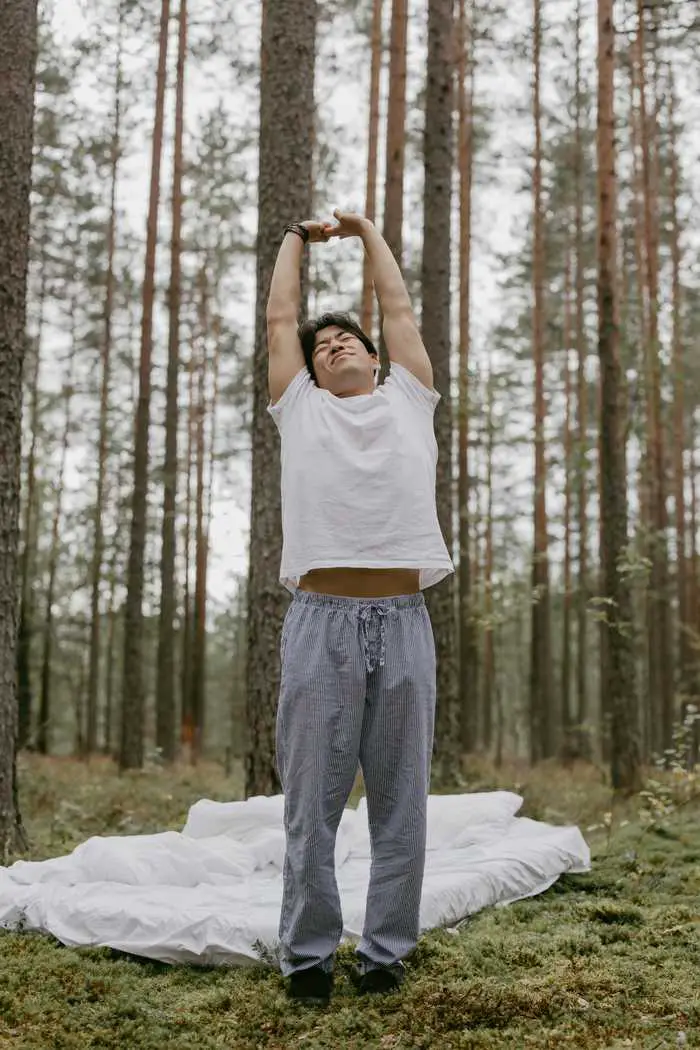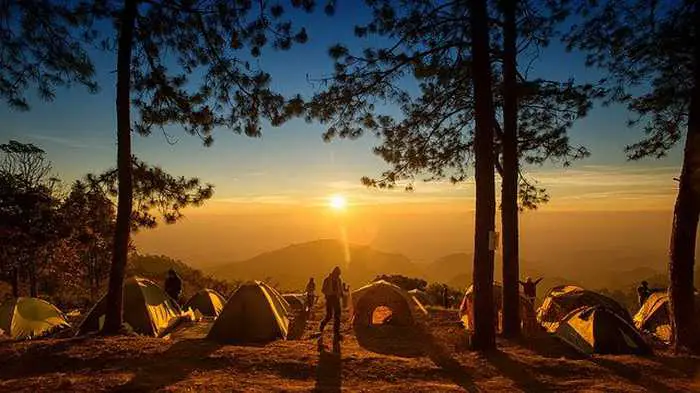Yes, you can sleep in a hammock just about anywhere. Outside of high mountains, featureless plains and the like, many landscapes provide all you need to swing your hammock.
Trees are the most common support for hammocks, but you can also use posts, boulders, or other sturdy objects. As long as you have two points to attach your hammock and enough space to lie down comfortably, you can catch some Zs just about anywhere.
Is sleeping in a hammock a good idea?
Yes, sleeping in a hammock is definitely a good idea! There are many benefits to doing so, including getting better rest, aiding your body and mind in recovery after a long day, providing more support for your back, eliminating the risk of bed bugs, and even curing insomnia.
Hammocks are also significantly cheaper than mattresses – which can cost as much as $5,000 – making them a great option for budget-minded individuals.
Can you sleep in a hammock permanently?
Yes, you can sleep in a hammock permanently. However, the quality of your sleep and your comfort throughout the night depend largely on the type of hammock that you use. A quality hammock for sleeping will also ensure that you don’t experience any back pain or other discomfort during the night.
There are many different types of hammocks available on the market, so it is important to choose one that is specifically designed for sleeping. Some factors to consider when choosing a hammock include:
- The size of the hammock. You should choose a size that is comfortable for you and large enough to accommodate your body comfortably.
- The material of the hammock. Hammocks can be made from various materials, such as cotton, nylon, or polyester. Choose a material that is strong and durable but also soft and comfortable against your skin.
- The weight capacity of the hammock.
Can you sleep in a hammock in the winter?
Yes, it is possible to sleep in a hammock during cold winter nights, but you need to be aware of “cold butt syndrome.” This happens when parts of your body that press against the fabric get cold because they are more susceptible to the wind. To avoid this, make sure you have a good insulation layer between you and the hammock.
How do you set up a hammock anywhere?
One great way to set up a hammock is to use two poles or other round supports. This can be done almost anywhere, using objects such as telephone poles or fence posts. Simply tie the hammock around both poles, making sure that the knots are secure and that the pole is stable enough to support your weight. With this method, you can enjoy your hammock in any number of locations.
How do you set up a hammock?
There are a few things you’ll need to set up a hammock, including two trees or other sturdy supports and some rope or straps. Once you have your supplies, follow these steps:
1. Choose your location carefully. Look for two trees that are the right distance apart and make sure there’s nothing sharp nearby that could tear your hammock.
2. Attach the ropes or straps to the trees at about waist height. You can use knots or loops to do this.
3. Spread out the hammock material and climb into it. Make sure it’s not too tight so you can be comfortable.
What kind of hammock is best for sleeping?
There is no one-size-fits-all answer to this question, as the best hammock for sleeping will vary depending on your individual needs and preferences. However, we can narrow it down to a few key factors that you should keep in mind when making your decision.
First and foremost, comfort is crucial when it comes to finding the perfect hammock for sleeping. You’ll want to look for a hammock with soft, breathable fabric that won’t irritate your skin. The Yellow Leaf Mojave Hammock is widely regarded as the most comfortable option on the market, thanks to its ultra-soft cotton construction.
Another important consideration is air circulation. When you’re lying in a hammock all night, you need to be sure that there’s adequate airflow around you to prevent overheating. The Hammocks Rada is an excellent choice for those looking for good air circulation, thanks to its open weave design.
Finally, durability is another important factor to consider when choosing a sleeping hammock. After all, you don’t want your investment falling apart after just a few uses! The ENO SingleNest Hammock is made from high-quality materials and construction, making it one of the most durable options on the market.
Can I set up a hammock in a park?
Yes, you can set up a hammock in most national parks. There are some specific guidelines that you need to follow, depending on whether you’re in a designated campground or backcountry camping.
Does a hammock count as a tent?
A hammock definitely counts as a tent! In fact, it’s even better than a regular tent because it’s so versatile. With a hammock, you’ve got a comfortable place to sit or sleep no matter where you are. You can use it as a chair around the campfire, or hang it up to cook your food if necessary. It’s also great for just relaxing and reading a book while enjoying the outdoors.

Can you sleep overnight in a hammock?
Most people can safely nap in a hammock on occasion, but if you’re looking to do it every night, you should talk to your doctor first. The practice may cause side effects like back pain or poor posture.
How long should a hammock be to sleep in?
Most people find that a hammock length of 10 feet (120 inches) is ideal for sleeping in. However, if you are under 5′ 6″, you can go somewhat shorter, and if you are taller than 6′, you can go up to 11 feet (132 inches).
Can you put a hammock anywhere?
No, you cannot put a hammock just anywhere. Poles and other round supports are great places to hang your hammock because they provide stability. You can find a pole or post almost anywhere, such as telephone poles or fence posts. Just be sure to carefully pick your pole, ensuring that it’s stable enough to support your weight. You may want to give it a good shake to make sure it’s sturdy before getting in.
Can sleeping in a hammock damage your back?
Assuming you’ve set up your hammock properly, sleeping in one should not damage your back. In fact, you’re actually less likely to toss and turn in a hammock thanks to how they hold you. This is also why a hammock won’t hurt your back, either.
Is sleeping in a hammock camping?
Yes, sleeping in a hammock is considered camping. Hammock camping simply means you’re swapping out your typical tent in favor of a hammock and a few helpful accessories where you can comfortably sleep outdoors overnight. Many backpackers and bikepackers enjoy camping with hammocks because they are so lightweight and take up little space in a pack.








